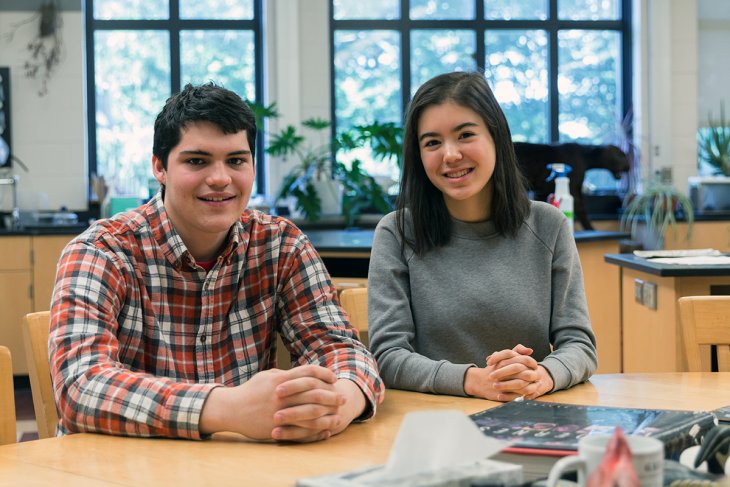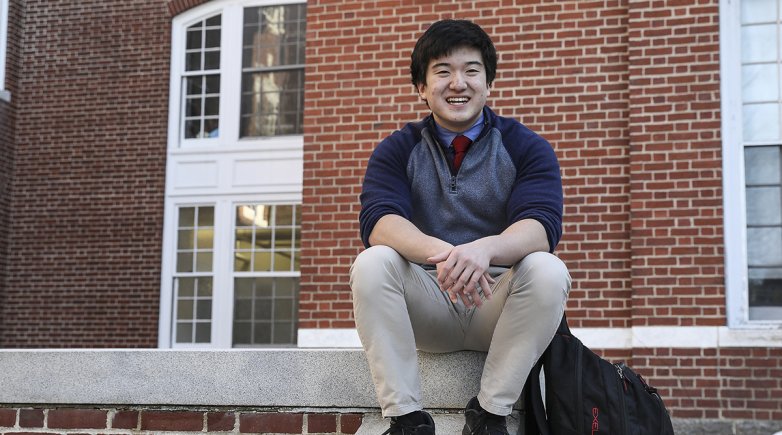Emily Gaw and Alexander Kish

"It was incredible to be able to craft my own experiment from start to finish based on my personal interests."
What can a roundworm and a water flea tell us about human health and our environment?
Emily Gaw ’20 and Alexander Kish ’20 hope to find out. The aspiring scientists were among a select group of middle- and high-school students who spent three weeks of their summer vacation at a science program hosted by the New Hampshire Academy of Science (NHAS). Gaw studied the effects of insulin and glucose on C. elegans, a roundworm; Kish studied how water polluted by leached plastics affects Daphnia magna, a species of water flea (both organisms are frequently used to study genetics and developmental biology).
Mentored by scientists, the students researched, designed and conducted original experiments at NHAS’s state-of-the-art STEM lab in Lyme, New Hampshire. At the end of the session, they presented their research to fellow students and a panel of STEM professionals. Both were subsequently invited to submit papers about their research; if selected, they’ll join the American Junior Academy of Sciences, a national high school honor society, and will present their findings at the annual American Association for the Advancement of Science meeting in 2019.
Established in 2016, the NHAS summer session is unique for its programs, well-equipped laboratory, and faculty, which includes Ph.D. scientists and engineers. “It’s the only lab in New England dedicated to high school students performing original scientific research of their own design,” says Dr. Peter Faletra, executive director of NHAS and a member of the faculty. “It gives students a unique opportunity to use advanced scientific instruments seldom available to them, under the mentorship of accomplished research scientists.”
Kish agrees. “It’s different from a classroom setting where you have a set curriculum,” the Haverhill, Massachusetts, native says. “The program is open to whatever research you want to do. You learn a lot because you’re doing a lot of preparation carrying out the experiment, then writing a formal scientific paper.”
Sugar overdose
Winner of a scholarship to the NHAS summer program, Gaw, a resident of McLean, Virginia, is fascinated by the health effects of our food choices. Her initial research on the topic uncovered some startling facts and drove her decision to study the connection between glucose and insulin and autoimmune diseases. “Since 1700, human consumption of sugar has increased from 20 pounds a year to over 100 pounds,” she says. “That high exposure to glucose is linked to diabetes, cancer, obesity and other diseases. I wanted to find the tipping point where too much sugar is consumed and how that could increase incidents of autoimmune disease.”
Gaw’s experiment involved exposing roundworms to large amounts of sugar, then recording the results. The worms were placed in petri dishes containing glucose solutions; Gaw moved them out of the dishes every two days, studying their growth under a microscope. A group of “single-shock” worms was exposed once to the glucose solution, then removed for study; a second group, the “double-shock” worms, was exposed to the glucose solution twice, with a two-day break in between exposures. A control group was exposed to glucose for eight days. The longer the worms were exposed to the sugary substance, the shorter their life spans were. To Gaw’s surprise, the double-shock worms lived longer than the single-shock worms. “I think that may be because the worms were exposed to glucose, then taken off, and the two-day break may have given the worms’ cells time to adapt to the glucose,” she says. She performed an identical experiment using insulin and the worm groups followed the same pattern.
Gaw hopes to continue studying her findings more in depth this year at Exeter. “I want to study the whole life span of C. elegans and get more concrete results of the patterns I was observing,” she says.
Don't drink the water
Kish is no stranger to the NHAS STEM lab: He attended Crossroads Academy, where the lab is located, in middle school, and Faletra was his science teacher. Combining an interest in engineering with biology, Kish has been the lab’s resident engineer for several years, trouble-shooting technical problems with its microscopy equipment. He returned to the lab this summer to explore scientific procedures.
Kish’s project took a real-world problem — the effects of high heat on plastic water bottles and baby-food containers left in a hot car — and the subsequent health effects of leached plastics in water on Daphnia magna, the water flea. Using a lab oven, Kish warmed different types of plastic and glass bottles filled with artesian well water (the type of water where Daphnia magna grows), then tested the amount of plastic leached into the water from each bottle. He set up a microscope to take slow-motion video of the fleas’ heart rates. “I found the leached waters were statistically different from the controls, which didn’t contain plastic,” Kish says. “All of the water from the plastic bottles made a difference on the Daphnia, usually slowing down their heart rate.”
Like Gaw, Kish hopes to continue his research. “Plastic is everywhere,” he says. “If it’s having a negative effect that poses an issue to our health, that affects the entire world population.”
Both students feel their time in the lab was well spent. “I enjoyed working through the scientific process the most,” Gaw says. “It was incredible to be able to craft my own experiment from start to finish based on my personal interests.”
Editor's note: This article first appeared in the fall 2018 issue of The Exeter Bulletin.



